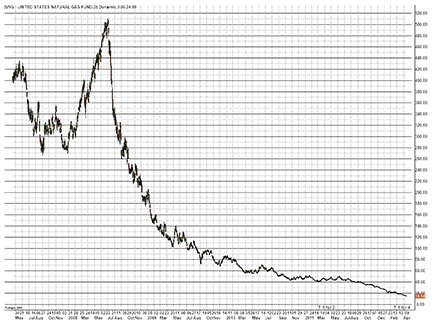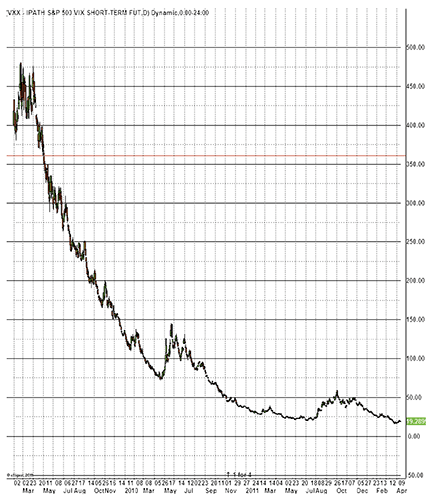
FIGURE 1: UNG
Q&A

Confused about some aspect of trading? Professional trader Don Bright of Bright Trading (www.stocktrading.com), an equity trading corporation, answers a few of your questions. To submit a question, post it on the Stocks & Commodities website Message-Boards. Answers will be posted there, and selected questions will appear in future issues of S&C.
UNEQUAL CREATION
I have been watching various exchange traded funds (ETFs) and exchange traded notes (ETNs) during the day and have found that I need to keep them overnight since I’m still bullish, but they did not go my way. I have read from Direxion that leveraged ETFs are made for daytrading only. What are your feelings about standard ETFs and especially ETNs? —RonJMemphis
Good questions, and I can start out by saying “Stop” — stop keeping any of these products overnight until you understand much better how they work. And by the way, because something goes against you is not a reason to keep it overnight. Traders need to find an actual edge in their trading, even their directional trading, especially when keeping overnight. I asked Rob Friesen, my resident expert on pairs and derivates, to chime in on this question. Friesen is a trader/member and has been a manager for Bright Trading for more than 14 years. He also manages www.pairtrader.com for equity pair traders. His reply:
Not all ETFs are created equal. As a manager of traders for the last 14 years, I often find my traders in strange trades with no perceived edge. I question them on a particular trade and find out that they have an opinion about something. Sometimes it is based on false assumptions and sometimes it is just a lack of knowledge. Often, their trades are a desire for a home run. Wall Street seems to capitalize on the weaknesses and vices of its participants and continues to create products that benefit the creators of the products but not the trader/investor. Even professional traders can get fooled into making bad trades.
Some of these trades occur using the leveraged ETFs, and there has been quite a bit of banter about them over the last three years, so I think more people understand them now. The long and short of it is that these products do not perform as advertised. Another class of products with the characteristics of leveraged ETFs is the ETFs with underlying portfolios of futures. Yet another class of products that surprise the uninformed and the speculators is the ETN.
Now for specifics: Let’s look at one ETF and one ETN. The United States Natural Gas Fund (UNG) is an ETF that holds no equities. Rather, it is a fund that invests in near-month natural gas futures that trade on the NYMEX. The fund has to avoid physical delivery of the commodity, so it rolls its contracts before they expire forward to the next month. Problem: UNG futures are in a constant state of contango (that is, longer-dated futures that are above the spot, causing rolling futures to have a loss), so UNG loses money each time it rolls positions. In addition, it has 0.60% expense ratio, and it uses swaps in its new-share creation instead of natural gas futures because it has reached its purchase limits. Many use this product as an asset allocation strategy. Is it wise to invest in it with the current contango, the depreciation, and the risks? Is it wise to buy it and hope for a bounce while you sit through the decay?
So investors may have a positive outlook on the future of natural gas as it becomes more prevalent in our energy landscape. This leads them to look to UNG (Figure 1) as a vehicle for their bullish attitude. It will most likely underperform the futures and the commodity. I ran a comparison from December 31, 2009, until April 10, 2012, and the UNG lost -17.5% relative to NGF, which it is supposed to track.

FIGURE 1: UNG
VXX is an ETN that is an unsecured note issued by Barclays Bank, which means it has credit risk, so a concern would be the financial health of Barclay’s as the counterparty. It has an expense ratio of 0.89%, which means if you hold it for a year, you have lost almost 1% relative to the futures at a minimum. Due to volatility futures being used to hedge against a rise in volatility, the VIX futures markets remain in contango.
Due to the contango of the futures and the expense ratio of the ETN, to own long the VXX product is a negative expectation game. It has decay, as you can see from Figure 2.

FIGURE 2: VXX
I ran an analysis of VXX from December 31, 2009, to April 10, 2012, and found that the VXX lost -79% relative to the VIX futures. That does not bode well. And traders want to speculate on volatility by trading the VXX long and investors/institutions want to hedge portfolios from volatility through buying the VXX long position? Bottom line: Find better trades. Stop playing these instruments speculating on a bounce.